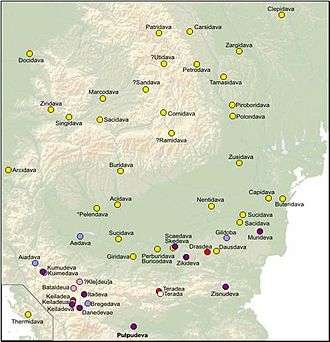Dinogetia
| Castra Dinogetia | |
|---|---|
|
Panoramic view | |
 Location within Romania | |
| Abandoned | end of the 6th century AD |
| Attested by | Notitia Dignitatum |
| Previous fortification | Dacian |
| Place in the Roman world | |
| Province | Moesia Inferior |
| Directly connected to | Tirighina-Bărboși • Noviodunum • Arrubium |
| Structure | |
| — Stone structure — | |
| Towers | 14 |
| Stationed military units | |
| — Legions — | |
|
I Iovia Scythica | |
| — Cohorts — | |
|
I Cilicium | |
| — Classis — | |
| Flavia Moesica | |
| Location | |
| Town | Gărvan |
| County | Tulcea |
| Country |
|
| Reference | |
| RO-RAN | 160635.03 |
| Site notes | |
| Condition | Ruined |
Dinogetia was an ancient Geto-Dacian settlement and later Roman fortress located on the right (southern) bank of the Danube near the place where it joins the Siret. The Dinogetia site is situated in Northern Dobruja at 8 kilometres east of Galați, Romania and 2 kilometers north of the village Gărvan.
Roman and Byzantine period
The Geto-Dacian settlement was conquered by the Romans and transformed into a boundary fortress. The site was mentioned by Ptolemy. Located in the center of an arch made by the Danube around Macin, Galați and Gura Prutului, the Roman fortress of Dinogetia-Garvãn had initially been a castellum (a small fortress), having its role in the defensive system on the Lower Danube. Some other important Roman fortresses at the time, were those from Barbosi (Galați County) and Troesmis (Tulcea County). Having had a great importance in Constantine the Great's time, the fortress was reinforced since Diocletian. In Anastasius' and Justinian's time some structures were added to the stronghold. But, by the end of the 2nd century AD, when the great barbarian invasions had begun, Dinogetia increased its importance, especially after the abandon by the Romans of the Dacian province. Its strategic position in the north-western corner of Dobrudja, gave the fortress an important role in the defensive system of the province.
After a period of rebuilding during the Severan period, in the 3rd century Dinogetia was again a target for the barbarian invaders. After the abandon of Dacia, the strategic importance of the site had increased, Aurelian, Probus and Diocletian thus initiating a policy of fortification of the entire Danubian limes, Dinogetia included. During the Late Antiquity Dinogetia had a key role in the defensive system of the Roman province. Anastasius, then Justinian reinforced the fortress' walls. The attack of the Avars/Kutrigurs under Zabergan's command in 559 had disastrous consequences for the stronghold.
Archaeological research has uncovered ruins of a large house, a Roman bath, a church, a basilica and a graveyard outside the wall. These ruins had been heavily damaged by a feudal site built over the Roman one.

The Diocletian constructed wall (c. 3 m wide) has fourteen horseshoe-shaped towers .
- Buildings located on the Dinogetia Site:
- praetorium
- the ruins of a large house
- 4 c basilica
- 4 c ruins of a Roman bath
- 9 C church
- Stamped Bricks
From the Later Roman Empire there are registered at Dinogetia bricks stamped with the mark of Legio I Iovia (Scythica) and the presence of Gothic federates as well. Also, the 4th century witnessed the building of "the house of the commander" (domus), as well as the baths, the last perhaps built even earlier, according to the last archaeological finds. Also, the written sources, such as Notitia Dignitatum, certify some milities Scythici (NDOr, XXXIX, 24), thus a confirmation of the archaeological evidence. In the ecclesiastical sources there are registered Christian martyrs dated in the reign of Licinius, especially from the army, thus certifying the Christianization of the area. Other army units that were stationed at Dinogetia include: Legio V Macedonica, Cohors I Cilicum, Cohors II Mattiacorum, cl. fl. Moesica (2nd century), Legio I Iovia (4th century)
The fortress had been inhabited until the end of the 6th or the beginning of the 7th century when, in the context of Phokas' rebellion, the entire limes of Lower Danube had collapsed under the pressure of Slav tribes. In this context, Dinogetia also was abandoned as a military strongpoint. The fortress was rebuilt and became the siege of a Byzantine garrison after the successful campaigns of the emperor Ioannes Tzimiskes (969-976) against the Kievian Russians, when Dobruja was again incorporated to the Empire. The presence of Byzantine troops is certified until the 12th century, when Dinogetia was gradually deserted and finally abandoned perhaps in 1186.
Middle Age period
9th-century church findings:
Wall paintings traces
-
Public Baths
-
tower
-

Site Panoramic View
-
Byzantine Church
-
Tower
See also
References and Archeologists
- Professor Ion Barnea works http://biserica.org/WhosWho/DTR/B/IonBarnea.html
- Professor Doctor Alexandru Barnea http://www.unibuc.ro/ro/cd_alebarnea_ro
- Cristian Olariu, Dinogetia article on www.geocities.com
- STRATEG. Strategii defensive şi politici transfrontaliere. Integrarea spaţiului Dunării de Jos în civilizaţia romană
- Alexandru Barnea Article
- Alexandru Barnea Article
- Alexandru Barnea Article
- Alexandru Barnea Article
- Alexandru Barnea Article
- Alexandru Barnea Article
Coordinates: 45°22′45″N 28°08′19″E / 45.3792°N 28.1387°E
